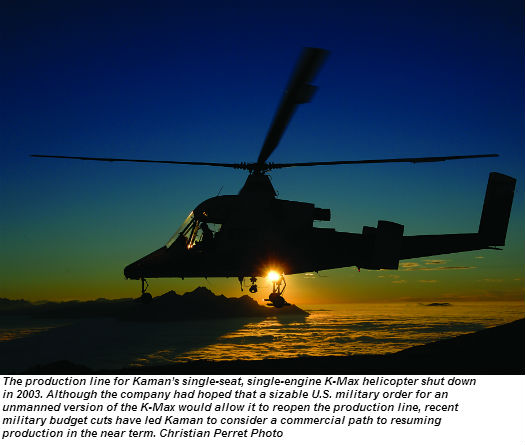
Twenty years after the Kaman K-Max achieved United States Federal Aviation Administration certification, Kaman has said it is willing to consider resuming commercial production of the intermeshing- rotor utility helicopter with sufficient commitments from prospective customers.
Kaman made the announcement at Heli-Expo 2014 in Anaheim, Calif., where Kaman Aerosystems Division president Jim Larwood stated, “There is clearly demand for new aircraft to support firefighting, logging or any industry requiring repetitive aerial lift capabilities, and the K-Max is extremely well suited for all of these industrial applications. We have developed plans to reopen production for potential military programs. However, if we can establish sufficient firm commitments from commercial customers now, we are prepared to seek approval from our board to reopen the line.”
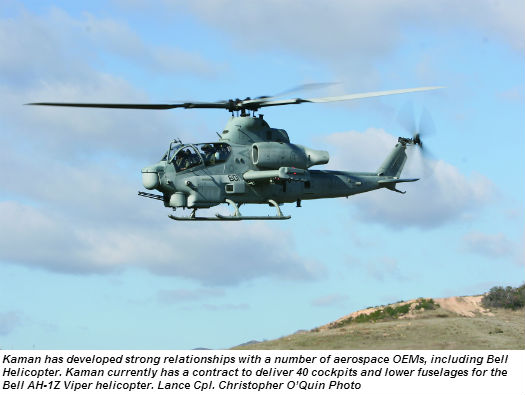
The K-Max production line shut down in 2003 after producing 38 aircraft. Although the model is no longer in current production, K-Max helicopters continue to operate around the world in a variety of heavy-lift utility applications, and, since 2011, an unmanned version of the K-Max developed with Lockheed Martin has been supporting the U.S. Marine Corps in Afghanistan.
Kaman previously indicated that a significant military order would allow it to resume production for both military and commercial customers. With the U.S. military presently hampered by severe budget constraints, however, commercial commitments now appear to be the more promising route for resuming production in the near term. Larwood suggested that commitments for at least 10 helicopters would encourage the company to re-open the K-Max production line.
Integrated Solutions
While the K-Max statement captured most of the attention for Kaman in Anaheim, it wasn’t the company’s only announcement. Kaman also spotlighted the integrated design and manufacturing work being performed by its newly restructured Aerosystems Group, which brings the company’s Engineering Services, Tooling, Composite Structures, Integrated Structures and Metallics, Testing, and Air Vehicles and MRO divisions under one umbrella.
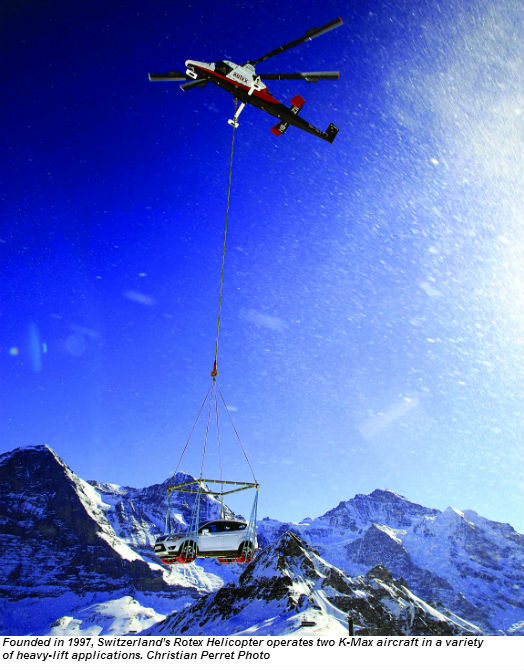
The Aerosystems Division recently achieved a major milestone when it delivered its 1,000th Black Hawk helicopter cockpit, including electrical harnesses and control mechanisms, to Sikorsky Aircraft. “I can recall when Sikorsky and Kaman did zero business together,” said Larwood, who has been with Kaman for 28 years and held two previous presidencies within the company before taking over the Aerosystems Division. Now, he said, Sikorsky and Kaman appear to “have found each other’s sweet spot.”
Kaman has developed strong relationships with other helicopter original equipment manufacturers (OEMs), too, including Bell Helicopter, Boeing and MD Helicopters Inc. At Heli-Expo, Kaman highlighted a contract to deliver 40 cockpits (including doors and transparencies), and lower fuselages (including skids), for the Bell AH-1Z Zulu helicopter. Two complete Zulu structures were delivered in 2013, and Kaman said production is set to accelerate in its Jacksonville, Fla., facility in 2014.
Kaman also manufactures skin-to-core composite layups for Bell commercial helicopter blades, and is on track to deliver the final CH-148 composite tail rotor pylons in 2014. Additional work, for Boeing, will continue this year with deliveries of CH-47 composite engine inlet screens, tunnel covers, and metallic assemblies.
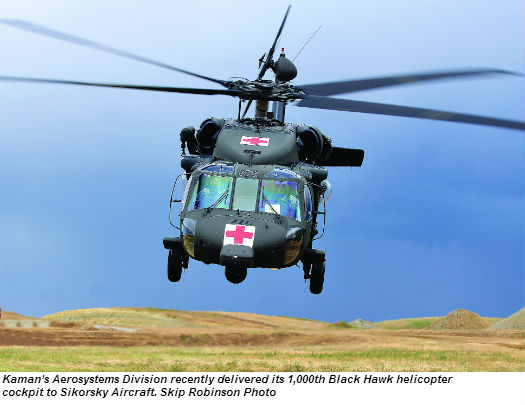
According to Larwood, the comprehensive services offered through Kaman’s Aerosystems Division have driven efficiencies in the blue-chip aerospace OEMs that rely on them. Often, he said, OEMs must outsource related work to multiple suppliers — and then figure out how to integrate the results. By contrast, Kaman can take on work packages up to and including complete designand- build commissions, delivering a finished product in return.
“The supply chain has been saddled with a bunch of little pieces that really should never have been pulled apart,” said Larwood. “To repackage it and offer that to our customers has been met with great excitement.”
In response to increased demand and potential, Kaman has been actively growing its Aerosystems capabilities — seen most recently in the opening of new offices for its Engineering Services subsidiary at the Clemson University Research Center in Charleston, S.C. Larwood said this expansion will meet growing requirements for engineering skills and talent, particularly for key customer Boeing, which Kaman is supporting with stress analysis work for 787 Dreamliner manufacturing. In addition to the opening of the Clemson office, a select team of Kaman employees will be co-located near Boeing’s North Charleston production facility, with supplementary support staff in Everett, Wash.
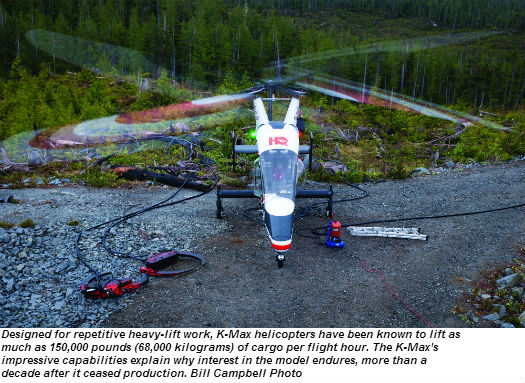
Additionally, two new Kaman facilities are slated to open in the first quarter of 2014, including a new stateof- the-art tooling facility in Lancashire, England, and a Kaman Specialty Bearings and Engineered Products facility in Hochstadt, Germany. At Heli-Expo, Kaman touted several new products from its Kaman Specialty Bearings and Engineered Products division, including a new, all-composite swashplate Uni-Ball that the company says will save weight, eliminate corrosion and improve reliability. Other self-lubricating bearings, which Kaman says offer exceptional performance against the AS81819 standard, are offered in titanium or in traditional corrosion-free alloys. And, the company’s flexible drive couplings now include a lightweight, single-piece titanium Tufflex for high-speed, large-angle misalignment in the main and tail drive systems.
Finally, at the same time as Kaman has been expanding its capabilities and presence, it has been working behind the scenes to ensure seamless integration between its widely distributed facilities — something the company recognizes as essential to preserving the benefits of its comprehensive services model. According to Larwood, the benefit to a Kaman customer will be in dealing with a single, unified entity — rather than working through multiple divisions. “We are seamless to ourselves and seamless to our customers,” he said.





